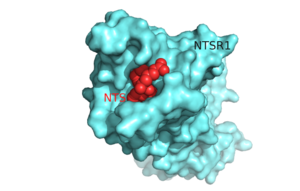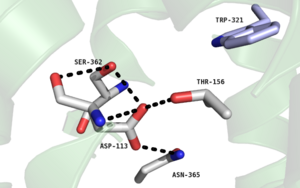Sandbox Reserved 1176
From Proteopedia
(Difference between revisions)
| Line 4: | Line 4: | ||
==Introduction== | ==Introduction== | ||
[[Image:Surface_Protein_red.png |300 px|below|thumb|'''Figure 1'''.Top view of NTSR1 protein (blue) interacting with NTS ligand (red)]] | [[Image:Surface_Protein_red.png |300 px|below|thumb|'''Figure 1'''.Top view of NTSR1 protein (blue) interacting with NTS ligand (red)]] | ||
| - | Neurotensin receptor 1 (NTSR1) is a '''[https://en.wikipedia.org/wiki/G_protein%E2%80%93coupled_receptor G-protein coupled receptor (GPCR).]''' GPCRs are a class of proteins with an extracellular binding domain and 7 transmembrane helices that assist in propagating a cellular response<ref name="SPGP"/>. This is accomplished by the binding of ligands to the GPCR outside the cell, causing a '''[https://en.wikipedia.org/wiki/Conformational_change conformational change]''' and activating a '''[https://en.wikipedia.org/wiki/Signal_transduction signal transduction]''' pathway via '''[https://en.wikipedia.org/wiki/Second_messenger_system second messengers]''' such as '''[https://en.wikipedia.org/wiki/Cyclic_adenosine_monophosphate cyclic AMP]''', '''[https://en.wikipedia.org/wiki/Inositol_trisphosphate inositol triphosphate]''', and '''[https://en.wikipedia.org/wiki/Diglyceride diacylglycerol]'''.<ref name="SPGP"/> The ligand for NTSR1 is the 13 amino acid peptide, neurotensin (NTS)<ref name="SONT">PMID:23051748</ref>, and the majority of the effects of NTS are mediated through NTSR1<ref name="SONT"/>. NTS has a variety of biological activities including a role in the '''[https://en.wikipedia.org/wiki/Leptin leptin]''' signaling pathways <ref name="Mice">PMID: 20211191</ref>, tumor growth <ref name="cancer">PMID:16887236</ref>, and '''[https://en.wikipedia.org/wiki/Dopamine dopamine]''' regulation <ref name="Schizophrenia">PMID:22596253</ref>.Recently NTSR1 was crystallized bound with the C-terminus of its tridecapeptide '''[https://en.wikipedia.org/wiki/Ligand ligand]''', <scene name='72/721548/Neurotensin/7'>NTS(8-13)</scene>. The shortened ligand was used because it has a higher potency and efficacy than its full-length counterpart<ref name="SONT"/>. Class A GPCRs bind their ligands within the '''[https://en.wikipedia.org/wiki/Transmembrane_protein transmembrane]''' core in a ligand binding pocket. The<scene name='72/721547/Hydrophobic_binding_pocket/5'>hydrophobic binding pocket</scene> in NTSR1 is located at the top of the protein (Figure 1). NTSR1 also contains an '''[https://en.wikipedia.org/wiki/Allosteric_regulation allosteric]''' <scene name='72/721548/Na_bind_pocket/13'>sodium binding pocket</scene>, which is located directly beneath the ligand binding pocket and the two pockets are separated by the residue <scene name='72/721548/Trp321/1'>Trp321</scene><ref name="SPGP">PMID:26205105</ref>. NTSR1 has been mutated to exist in both <scene name='72/721548/Ntsr1-elf/6'>active</scene> and <scene name='72/721547/Ntsr1-gw5/8'>active-like</scene> states. This has led to a greater understanding of the structure of NTSR1 and how the structure influences its function. | + | Neurotensin receptor 1 (NTSR1) is a '''[https://en.wikipedia.org/wiki/G_protein%E2%80%93coupled_receptor G-protein coupled receptor (GPCR).]''' GPCRs are a class of proteins with an extracellular binding domain and 7 transmembrane helices that assist in propagating a cellular response<ref name="SPGP"/>. This is accomplished by the binding of ligands to the GPCR outside the cell, causing a '''[https://en.wikipedia.org/wiki/Conformational_change conformational change]''' and activating a '''[https://en.wikipedia.org/wiki/Signal_transduction signal transduction]''' pathway via '''[https://en.wikipedia.org/wiki/Second_messenger_system second messengers]''' such as '''[https://en.wikipedia.org/wiki/Cyclic_adenosine_monophosphate cyclic AMP]''', '''[https://en.wikipedia.org/wiki/Inositol_trisphosphate inositol triphosphate]''', and '''[https://en.wikipedia.org/wiki/Diglyceride diacylglycerol]'''.<ref name="SPGP"/> The ligand for NTSR1 is the 13 amino acid peptide, neurotensin (NTS)<ref name="SONT">PMID:23051748</ref>, and the majority of the effects of NTS are mediated through NTSR1<ref name="SONT"/>. NTS has a variety of biological activities including a role in the '''[https://en.wikipedia.org/wiki/Leptin leptin]''' signaling pathways <ref name="Mice">PMID: 20211191</ref>, tumor growth <ref name="cancer">PMID:16887236</ref>, and '''[https://en.wikipedia.org/wiki/Dopamine dopamine]''' regulation <ref name="Schizophrenia">PMID:22596253</ref>.Recently NTSR1 was crystallized bound with the C-terminus of its tridecapeptide '''[https://en.wikipedia.org/wiki/Ligand ligand]''', <scene name='72/721548/Neurotensin/7'>NTS(8-13)</scene>. The shortened ligand was used because it has a higher potency and efficacy than its full-length counterpart<ref name="SONT"/>. Class A GPCRs bind their ligands within the '''[https://en.wikipedia.org/wiki/Transmembrane_protein transmembrane]''' core in a ligand binding pocket. The <scene name='72/721547/Hydrophobic_binding_pocket/5'>hydrophobic binding pocket</scene> in NTSR1 is located at the top of the protein (Figure 1). NTSR1 also contains an '''[https://en.wikipedia.org/wiki/Allosteric_regulation allosteric]''' <scene name='72/721548/Na_bind_pocket/13'>sodium binding pocket</scene>, which is located directly beneath the ligand binding pocket and the two pockets are separated by the residue <scene name='72/721548/Trp321/1'>Trp321</scene><ref name="SPGP">PMID:26205105</ref>. NTSR1 has been mutated to exist in both <scene name='72/721548/Ntsr1-elf/6'>active</scene> and <scene name='72/721547/Ntsr1-gw5/8'>active-like</scene> states. This has led to a greater understanding of the structure of NTSR1 and how the structure influences its function. |
== Structure == | == Structure == | ||
| Line 17: | Line 17: | ||
===Na<sup>+</sup> Binding Pocket=== | ===Na<sup>+</sup> Binding Pocket=== | ||
[[Image:Na+ Proteopedia Picture.png |300 px|left|thumb|Figure 2. Residues of the collapsed sodium binding pocket. Trp321 (blue) sets the top of the pocket, where Ser362, Asp113, Thr156 and Asn365 (gray) are involved in hydrogen bonding interactions preventing the coordination of a Na<sup>+</sup> ion.]] | [[Image:Na+ Proteopedia Picture.png |300 px|left|thumb|Figure 2. Residues of the collapsed sodium binding pocket. Trp321 (blue) sets the top of the pocket, where Ser362, Asp113, Thr156 and Asn365 (gray) are involved in hydrogen bonding interactions preventing the coordination of a Na<sup>+</sup> ion.]] | ||
| - | <scene name='72/721548/Trp321/1'>Trp321</scene>, which is positioned at the bottom of the <scene name='72/721547/Hydrophobic_binding_pocket/5'>hydrophobic binding pocket</scene>, sets the top of the <scene name='72/721548/Na_bind_pocket/12'> | + | <scene name='72/721548/Trp321/1'>Trp321</scene>, which is positioned at the bottom of the <scene name='72/721547/Hydrophobic_binding_pocket/5'>hydrophobic binding pocket</scene>, sets the top of the <scene name='72/721548/Na_bind_pocket/12'> Na<sup>+</sup> binding pocket</scene>. The Na<sup>+</sup> ion binding pocket acts as a negative allosteric site for G protein activity <ref name="SPGP"/>. When Na<sup>+</sup> enters the Na<sup>+</sup> ion binding pocket, it coordinates with Asp95, Gln131, Ser135, and Asp113, decreasing the signaling activity of NTSR1 <ref name="SPGP"/>. When NTSR1 is in its active state, the Na<sup>+</sup> ion binding pocket is collapsed. This prevents the regulation of protein activity through a Na<sup>+</sup> ion, as the Na<sup>+</sup> ion is unable to coordinate via a salt bridge to Asp113 (Figure 2). The side chain atoms of Asp113 form a '''[https://en.wikipedia.org/wiki/Hydrogen_bond hydrogen bond]''' network with Thr156, Ser361, Ser362, and Gln365 instead, which prevents the coordination of a Na<sup>+</sup> ion<ref name ="SPGP"/> (Figure 2). |
==Activation of NTSR1== | ==Activation of NTSR1== | ||
Revision as of 02:56, 22 April 2016
| |||||||||||
References
- ↑ 1.00 1.01 1.02 1.03 1.04 1.05 1.06 1.07 1.08 1.09 1.10 1.11 1.12 1.13 1.14 1.15 1.16 1.17 1.18 1.19 1.20 1.21 1.22 1.23 Krumm BE, White JF, Shah P, Grisshammer R. Structural prerequisites for G-protein activation by the neurotensin receptor. Nat Commun. 2015 Jul 24;6:7895. doi: 10.1038/ncomms8895. PMID:26205105 doi:http://dx.doi.org/10.1038/ncomms8895
- ↑ 2.0 2.1 2.2 2.3 2.4 2.5 2.6 2.7 White JF, Noinaj N, Shibata Y, Love J, Kloss B, Xu F, Gvozdenovic-Jeremic J, Shah P, Shiloach J, Tate CG, Grisshammer R. Structure of the agonist-bound neurotensin receptor. Nature. 2012 Oct 25;490(7421):508-13. doi: 10.1038/nature11558. Epub 2012 Oct 10. PMID:23051748 doi:http://dx.doi.org/10.1038/nature11558
- ↑ 3.0 3.1 3.2 3.3 Liang Y, Boules M, Li Z, Williams K, Miura T, Oliveros A, Richelson E. Hyperactivity of the dopaminergic system in NTS1 and NTS2 null mice. Neuropharmacology. 2010 Jun;58(8):1199-205. doi:, 10.1016/j.neuropharm.2010.02.015. Epub 2010 Mar 6. PMID:20211191 doi:http://dx.doi.org/10.1016/j.neuropharm.2010.02.015
- ↑ 4.0 4.1 4.2 Carraway RE, Plona AM. Involvement of neurotensin in cancer growth: evidence, mechanisms and development of diagnostic tools. Peptides. 2006 Oct;27(10):2445-60. Epub 2006 Aug 2. PMID:16887236 doi:http://dx.doi.org/10.1016/j.peptides.2006.04.030
- ↑ 5.0 5.1 5.2 Griebel G, Holsboer F. Neuropeptide receptor ligands as drugs for psychiatric diseases: the end of the beginning? Nat Rev Drug Discov. 2012 May 18;11(6):462-78. doi: 10.1038/nrd3702. PMID:22596253 doi:http://dx.doi.org/10.1038/nrd3702


